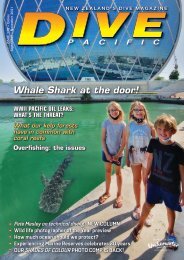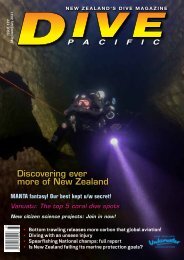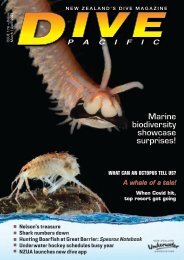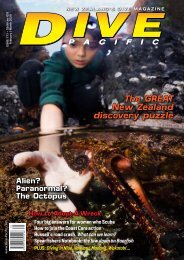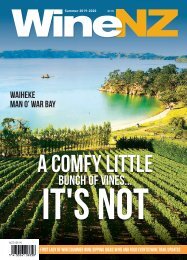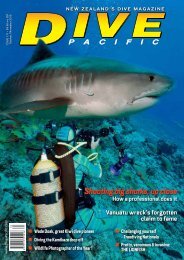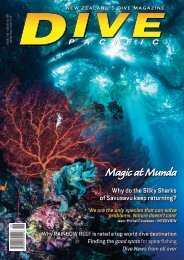Dive Pacific 175 Dec2020 Jan 2021
Dive Pacific, New Zealand's Dive Magazine , captures the best of diving in New Zealand and the Pacific. with adventures, top photos and expert technical advice
Dive Pacific, New Zealand's Dive Magazine , captures the best of diving in New Zealand and the Pacific. with adventures, top photos and expert technical advice
Create successful ePaper yourself
Turn your PDF publications into a flip-book with our unique Google optimized e-Paper software.
Counting fish at the<br />
Poor Knights (and Mokihinaus)<br />
By Harry Allard<br />
My research based at the Leigh Marine Laboratory focuses on the effects that<br />
no-take protection can have on fishes, including unexpected flow-on effects.<br />
At Leigh’s Cape Rodney-Okakari Point Marine Reserve, previous research<br />
showed how the recovery of predatory snapper and crayfish under protection impact kina,<br />
slowing their grazing and in turn allowing kelp forests recover, an example of the “indirect<br />
effects” of reserve protection flowing on from the protection of targeted species. The key<br />
aim of my PhD research is to investigate whether similar, indirect effects are common among<br />
fish species, and how they might vary at other marine reserves.<br />
The Poor Knights Islands are a star<br />
destination of New Zealand diving,<br />
previously shown off to television audiences<br />
around the world by famous people like<br />
Jacques Cousteau and David Attenborough.<br />
Situated in clear oceanic waters 23 km off<br />
the Tutukaka coast, these small islands<br />
are washed by the East Auckland Current<br />
bringing wildlife from warmer locations<br />
like Lord Howe Island near Australia which<br />
contributes to the Poor Knights’ diverse fish<br />
fauna,. Besides coastal staples like snapper<br />
and red moki, the Poor Knights are home<br />
to a host of colourful wrasses and rarer<br />
species as illustrated on these pages. Here,<br />
dramatic stone archways, grand caves and<br />
sheer sunken cliffs provide surreal settings<br />
for some truly special underwater sights.<br />
Recognising just how unique<br />
the Poor Knights were, in the<br />
1960s and 70s now-legendary<br />
conservationists like the late<br />
Kelly Tarlton, Roger Grace, and<br />
Wade Doak were instrumental<br />
in affording the islands partial<br />
protection from fishing in 1981<br />
moving into full no-take protection<br />
in 1998.<br />
Snapper armada<br />
At the Poor Knights, snapper<br />
have undergone a population<br />
boom, with an armada of large<br />
snapper moving in around 1998<br />
and holding fort ever since.<br />
But to figure out what other<br />
effects protection may have<br />
had, I needed to compare what<br />
happened at the Poor Knights to<br />
another, unprotected location.<br />
and for this I selected the<br />
Mokohinau Islands which is open<br />
to fishing, and has not experienced<br />
the same snapper boom.<br />
In the autumn of 2019, our<br />
small team headed out on<br />
the University of Auckland’s<br />
research vessel Hawere, diving<br />
for several days at both locations.<br />
We collected data to compare<br />
with previous fish monitoring<br />
results, often getting bitten by<br />
feisty Sandager’s wrasse in the<br />
process.<br />
Working on the data, it became<br />
clear that at the Poor Knights the<br />
snapper biomass (the estimated<br />
weight of all the fish combined)<br />
was on the rise, indicating a<br />
growing number of large, legalsized<br />
fish. In contrast, snapper<br />
biomass at the Mokohinau<br />
Islands remained low, consistent<br />
with a popular target species<br />
whose large individuals are<br />
frequently fished.<br />
www.dive-pacific.com 43



